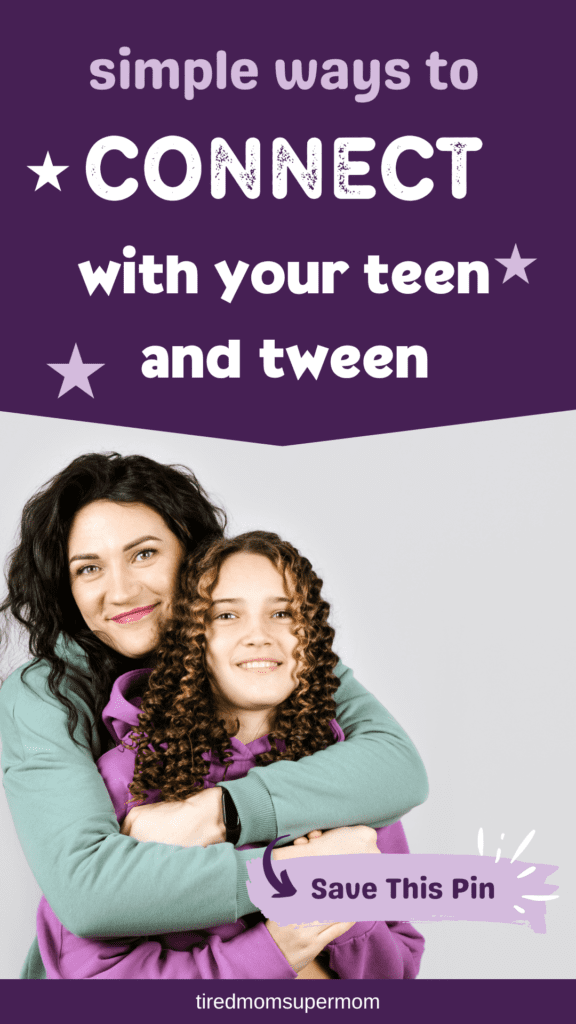How to Connect With Your Tween: 5 Proven Strategies for Stronger Bonds
Wondering how to connect with your tween in a way that actually works? These in-between years can feel like a parenting puzzle, but with the right tools and mindset, you can build a strong bond that lasts through the teen years and beyond.
It was a typical Tuesday evening in our house. The dinner table was filled with the usual chatter, but my 11-year-old daughter, Emma, sat quietly, pushing her food around her plate.
I had noticed this more often lately—the silence, the mood swings, the distance. She wasn’t my chatty little girl anymore, and I found myself aching for the connection we once had.
After dinner, I knocked on her door and gently asked if I could come in. She shrugged, eyes glued to her tablet. I took a deep breath and sat beside her. “Hey, Em, I miss you,” I said softly.
She glanced at me, and for a moment, I saw a flicker of the little girl who used to spill her day’s stories the second she got in the car. “Can we talk?”
Parenting a tween is like walking a tightrope. They’re on the cusp of independence but still crave our guidance and support—though they might not admit it. It’s a delicate balance of giving space, yet staying present.
As a mother of three, I’ve learned a few secrets that help me stay connected, even during the rollercoaster tween years.
Heads up: This post may include affiliate links. As an Amazon Associate, I earn from qualifying purchases—at no extra cost to you. Full privacy policy and disclosure here.

How to Connect With Your Tween: 5 Strategies That Actually Work
1. Create Space for Meaningful Conversations
If you’re wondering how to connect with your tween, the answer often starts with simply being present.
One of the biggest lessons I’ve learned is that quality time doesn’t always happen when it’s convenient.
For Emma, it’s often late at night when she’s winding down from her day. So, I adjusted my schedule, staying up a little later to sit on her bed and just talk.
Soft fairy lights in her room help create a cozy atmosphere for these heart-to-heart chats.
Sometimes, it’s not even about the big stuff—it’s about being there when they want to share something small, like a funny meme or what happened at school. I found that having a comfortable bean bag chair in her room has become her go-to spot for decompressing and chatting with me.
Many parents struggle with how to connect with their tween during the pre-teen years.
2. Find Common Interests
Finding things you can enjoy together is key. Emma and I recently discovered that we both love reading mystery novels.
Learning how to connect with your tween through shared interests can strengthen your relationship immensely.
We started a mini book club, just the two of us. I got her a set of age-appropriate mystery books, and every week, we discuss the latest chapter.
Whether it’s books, TV shows, or even a shared hobby like crafting, creating something special between you and your tween builds memories—and trust.
3. Respect Their Growing Independence
Understanding how to connect with your tween emotionally is key to building lifelong trust.
Tweens are figuring out who they are, and that means they need space to make decisions (even if they aren’t always the ones we would choose).
Emma wanted to redecorate her room to reflect her personality, so we shopped for trendy wall art and a new desk lamp together.
Letting her take the lead made her feel empowered, and it gave us an opportunity to bond over something she cared about.
4. Get Involved in Their World
These activities are simple, everyday ways to practice how to connect with your tween at home.
I used to think that Emma would naturally come to me when she needed to talk, but that wasn’t always the case.
So, I started learning more about her world—her favorite YouTubers, TikTok trends, and even the latest online games.
We bought a gaming headset so we could play a few games together, and it’s become a fun way to connect on her terms.
While we can’t always relate to everything, showing interest in what they love builds bridges. Plus, it opens the door for more conversations that aren’t forced but flow naturally.
5. Prioritize Time Together, Even When It’s Hard
One of the most overlooked parts of parenting is knowing how to connect with your tween without pressure.
Life is busy, especially with three kids. But I’ve found that my relationship with Emma thrives when I make time for just the two of us.
Whether it’s grabbing a weekend brunch or working on a simple DIY project together with craft kits we both love, these one-on-one moments are invaluable.
It doesn’t have to be elaborate—a simple walk or movie night can do wonders.
6. Listen Without Judgment
There’s a natural urge to fix everything for our kids, but tweens need to feel heard more than they need a solution.
When Emma tells me about friendship drama or school stress, I try to listen without immediately jumping in with advice.
Instead, I let her express her feelings and offer support, sometimes handing her a journal to help her process those emotions on her own terms.
Books and resources on how to connect with your tween can offer great insights — but your relationship matters most.
Bottom Line
Building a strong connection with your tween isn’t about grand gestures or being their best friend—it’s about showing up consistently, being present, and creating an environment where they feel safe and understood.
The more you focus on how to connect with your tween authentically, the easier it becomes to guide them through tough moments.
It’s in those quiet moments, like late-night talks under her cozy weighted blanket, where real bonding happens.
So, whether it’s spending a little extra time at the end of the day or finding a new shared hobby, know that the effort you put in now will pay off in a relationship that continues to grow through the teen years and beyond.
❓ FAQ Section
What are effective ways to connect with my tween?
Engage in activities they enjoy, maintain open communication, and show genuine interest in their daily experiences.
How can I encourage my tween to open up?
Create a safe and non-judgmental environment, listen actively, and avoid immediate reactions or judgments.
What if my tween resists spending time together?
Respect their need for space but consistently offer opportunities for shared activities without pressure.
How important is it to understand my tween’s interests?
Understanding their interests demonstrates support and can serve as a bridge for deeper connections.
Can shared hobbies strengthen our relationship?
Yes, engaging in shared hobbies fosters bonding and creates lasting memories.
Pin for Later!


Thanks for sharing. I read many of your blog posts, cool, your blog is very good.
As a busy working mom, I often feel like I don’t have enough time to connect with my tween. But your post reminded me that it’s the little moments that matter, like mealtime conversations and car rides. I’ll definitely be making an effort to be more present and engaged during these times. Thank you for the inspiration!
Thank you for this helpful post! I’ve been struggling to connect with my tween lately, but after reading your tips, I’m excited to try some of these ideas. I especially like the suggestion to use their interests to teach them new skills. Looking forward to bonding with my pre-teen more!